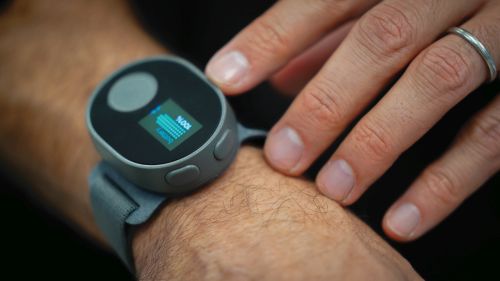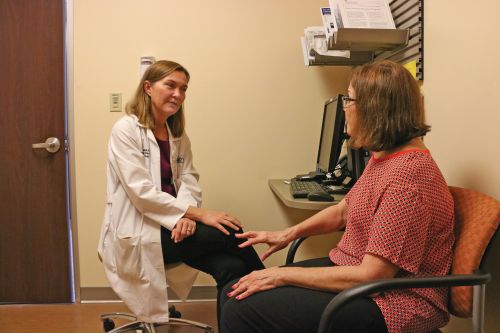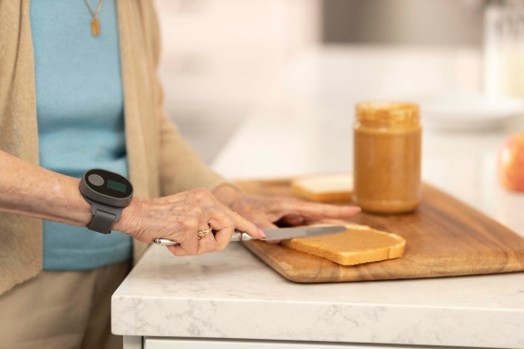Some new external and non-invasive technologies add to existing drug and surgical treatments
An estimated ten million people in the United States have a condition known as essential tremor (ET). Yet although it’s been recognized for over a century—it was originally known as senile tremor—there is relatively little awareness of it as a distinct medical condition. Sometimes mistaken for Parkinson’s disease, ET can lead to shaking of the arms and hands, and sometimes the head or torso. When severe, it can interfere with eating or drinking, writing, dressing, and even make some tasks impossible. Now, new approaches for treating the condition are emerging, potentially offering options to many patients whose life activities have been curtailed by ET.
Over the years, essential tremor has been treated with a variety of medications, including anti-seizure drugs and beta blockers, and in severe cases with brain surgery or deep brain electrical stimulation. These approaches have in many cases been helpful to patients, but often come with adverse side effects. Promising non-invasive approaches recently developed for treating ET include devices that are either worn externally or used in an outpatient, incision-free surgical procedure.

One device, which is simply worn on the wrist like a watch or a fitness monitor, was introduced in 2019 and is already exhibiting encouraging results helping those with ET overcome tremors and carry out daily tasks with greater control. Trio, designed by Cala Health, was FDA-approved in 2018 to be sold by prescription (Figure 1). The device works by using small sensors on the wrist to detect electrical signals sent from the brain that are causing the tremor, upon which a small electrical signal is then sent back to counter the frequency and cancel the tremors. In trials, Trio was found to be of some benefit to 85% of users, the company reports. The latest results of recent trials were shared in April 2021 at the American Academy of Neurology conference.

The company’s founder and chief scientific officer, Kate Rosenbluth (Figure 2), is an engineer and neuroscientist who performed deep brain surgery and neuromodulation of the brain for many years, explains Cala Health CEO Renee Ryan (Figure 3). While on a fellowship at Stanford, “she asked herself, is there a better way to do this? And she began to look at different ways to apply electrical signals to peripheral nerves, to have the therapeutic effect in the brain,” Ryan says.

The “aha moment,” Ryan says, came when Rosenbluth found that certain patterns of electrical signals applied externally to the skin could mimic some of the beneficial effects obtained from highly invasive brain surgery. This led to the development of devices that produce what the company refers to as TAPS—transcutaneous afferent pattern stimulation. “We do it in a very precise pattern. So the ‘aha’ was the need to do a pattern stimulation to get the therapeutic effect,” Ryan adds. To achieve that stimulation, there were no off-the-shelf devices available so the company developed a proprietary pulse generator to create the needed waveforms.
But that wasn’t enough to ensure a practical device that people could use in their daily lives. Most devices designed to make an electrical contact with the body use a sticky gel, Ryan says. “The challenge you have is that if you are a patient with hand tremors, trying to put a sticky hydrogel where it belongs is very difficult. We had to develop a much more patient-friendly skin interface.”

Cala’s vice president for hardware, Craig Schulte (Figure 4), says that the existing gels are also messy and need to be applied and removed with every use of a device. Instead, the wrist-worn Trio device uses a proprietary durable material. “It’s long-lasting,” he says. “We get 90 days use out of our carbon-nanotube silicone electrodes.” As a result, “this is something that you put on almost like a wristwatch, daily, or whenever you feel you need it.”

The wristwatch-like device houses all the electronics, battery, and three contact electrodes—one on the back of the wrist, and then one each on the median and radial nerves that run through the wrist. Each device must be personalized to a particular patient, precisely matching the frequency of the vibration in order to cancel it, Schulte explains. “That’s the secret sauce,” he says. “We read the frequency of the tremor and we adjust our waveform, our pattern stimulation, to match the frequency of the tremor.”
How well does it work? Holly Shill, a neurologist at St. Joseph’s Hospital and Medical Center and chair of the medical advisory board of the International Essential Tremor Foundation (Figure 5), says the foundation participated in the studies that led to Trio’s FDA approval and has used the device in clinics. “It’s a novel mechanism to treat essential tremor,” Shill says. “We’ve known for years that ET tremors are actually out of phase in the two hands, and so mechanically, when you put the hands together, they actually kind of phase-canceled each other,” she explains. Here, “the idea is, can you do the same thing, electrically? Can you send an electrical stimulation up that nerve that’s generating the signals for the muscle and dampen the tremors?”
In her own medical practice, Shill says that for some individuals this approach can be quite helpful. She adds that patients like it because it’s nonpharmacological, so they don’t have to take pills and deal with the side effects. That’s especially appealing, she says, because the condition mostly affects the elderly, who may already be on multiple medications.

Cala’s research is ongoing, Schulte says. “One of the interesting aspects of the device is that, because it’s connected to the cloud, we’re able to get feedback on patient progress,” he adds. Several hundred units have delivered so far and since the electrode wristband needs to be replaced every 90 days, the company can gauge the satisfaction rate. “We have a very high rate of customers who continue to be prescribed and receive bands to continue their treatment,” he says.
In a study published last year on a three-month trial with 263 patients using the Trio device twice a day, 62% of those with severe ET showed improvement, as did 68% of those with moderate ET. In the trials, patients wore the device twice a day for 40 minutes each time, which reflects what is expected to be a typical usage pattern, that is, using the device to help with certain specific activities such as cooking, eating, writing, among others (Figure 6). Another study released last year using data from motion sensors in the device showed that 57% of patients exhibited at least a twofold reduction in tremors at the end of a session, and 93% improved at least twofold at the times when the tremors were most severe.
For patients with more severe cases of essential tremor, such an external device may not be sufficient to allow them to resume their normal activities, and in such cases surgery or deep brain stimulation through implanted electrodes may still be the best option. However, a non-invasive option recently has become available that can eliminate the need for surgically penetrating the skull. Called focused ultrasound, the system uses a pair of high-intensity ultrasound sources at different angles, so the energy is concentrated where the two beams meet, and can be used to complete minor surgery from outside the head.
Exablate, a device produced by Insightec, is such a system. Exablate has shown significant improvements in patient outcomes over extended studies, and the device is approved for the treatment of tremor. Due to concerns about side effects, including possible effects on balance, the procedure is limited to use on just one side of the brain, and thus affects only one side of the body. The process does require shaving the patient’s head completely, since hair interferes with the ultrasound waves, Shill says. “It tends to be for the more advanced patients that have failed in other medical therapy,” she says.
One other non-invasive, wrist-worn device under development for less severe cases uses a purely mechanical vibration-damping system, based on the principles used to dampen wind oscillations in tall buildings or vibrations in airplane wings. The device uses a tuned mass attached to a glove-like housing the patient slips on, and it requires no batteries or adjustments and can be obtained over the counter. Developed by Thê´ Nguyen, a professor of mechanical engineering at Fresno State University in California who specializes in vibration control systems, the device is called Tremolo and is sold by a company called Five Micron.
Nguyen says that trials of the device show it can reduce tremors by 80% to 85% while it is being worn. It doesn’t work on all patients, he says, because its effectiveness depends on the orientation and complexity of the tremors, but for simple tremors that move in one or two planes, it can be beneficial. “We do have a very good number of people it actually has worked for, and when it worked, it clearly improved the quality of life. They can go out and eat in a restaurant, they can go to a family dinner without worrying about spilling. Some can actually even put a key in a lock,” Nguyen says.
However, the main resistance to the device, he finds, is based on its bulky size and appearance. Shill agrees, noting that the device is somewhat limited by its cosmetic aspects. For some patients, that may make it something that they would use in their own homes, but perhaps not out in public, “so there’s room for improvement,” she adds.
As the population ages, ET is likely to become an ever-greater issue. Shill points out that by age 60, about 5% of people have some degree of ET, and by age 80, it rises to 15% to 20%. Fortunately, the range of available treatments, and especially of the newer, non-invasive approaches, continues to expand, giving patients more choices in how to deal with this condition and improve their quality of life.



